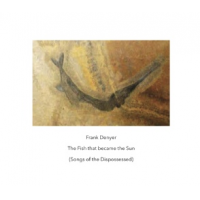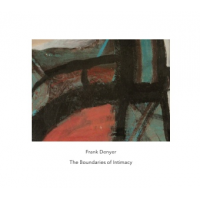Home » Jazz Articles » Multiple Reviews » Old and new Frank Denyer
Old and new Frank Denyer
Denyer has had a long and varied career which has taken him to many countries, both in his own right and as part of the Barton Workshop, with whom he plays piano. The two very different albums, below, feature Denyer compositions from 1974 onwards and convey the richness and variety of his music...
 Frank Denyer
Frank Denyer The Fish That Became the Sun (Songs of the Dispossessed)
Another Timbre
2019
In a 2018 interview Denyer told VAN magazine, "I wrote a large piece for 35 musicians, "The Fish that became the Sun," years ago. The majority are invented instruments, 89 new instruments, including eunuch flutes. Nobody knows what they are—I have all the instruments, they're in my garage. At about 50 minutes long it has never been performed. The one thing I want to get done in this life is to get it performed."
This piece was composed between 1991 and 1996, the time span being an indication of its epic scale. That is further emphasised by the large number of musicians who were involved in recording it, the range of voices used and instruments played, including eighty-seven made of discarded materials (referred to as "garbage instruments" in Michael Turnbull's sleeve notes; metal bicycle basket, anyone?) Denyer's own sleeve notes for the album describe in minute detail the locations of the musicians, all the way from a solo violinist onstage to eight cornets outside and surrounding the venue which, for this recording, was the Menuhin Hall, Stoke d'Abernon, Cobham, Surrey, in April 2018. Such attention to detail is also reflected in the score which was fully written-out, with no room for improvisation as such.
Totalling fifty-seven minutes, the piece builds from an introductory passage from that lone violin, through to an epic finale which features a dialogue between the cornets outside and the musicians inside throughout its eleven-minute duration. Curiously, although the composition plays continuously and is not sub-divided into sections, on the disc it is divided into fourteen tracks, which has the effect of emphasising its episodic nature. Despite the number of musicians involved, they are not all heard together, which means that frequent shifts occur throughout the piece, sometimes quite unexpectedly; track 12's shift from a promising percussion ensemble to a vocal interlude featuring two small children is one of the less predictable non-sequiturs. The glue that holds everything together throughout the piece is provided by the harmonious vocal passages which predominate, sometimes having to soldier on in the face of competition from the sounds of those garbage instruments.
The happy end to this story is that "The Fish that became the Sun (Songs of the Dispossessed)" received its world premiere at the 2019 Huddersfield Contemporary Music Festival and was hailed as a masterpiece. Given the logistical issues it poses, the next performance may be many years away, so anyone wishing to hear it will need to refer to this recording.
 Frank Denyer
Frank Denyer The Boundaries of Intimacy
Another Timbre
2019
Compared to the scale of the music on the above album, that on The Boundaries of Intimacy seems far more modest and intimate. Of its thirteen tracks, five feature a lone player, one has a trio and the remaining seven quartets. In several cases, the title of a piece practically describes the line-up, such as the engrossing opener, "Mother, Child and Violin" in which a mother's fragile, wordless vocals lead, followed by those of her child, sometimes in imitation, with the violin remote from them; the music makes it seem that strong, dramatic forces are at work but these are never made explicit and remain unresolved; edge of the seat listening.
Just as intriguing are the six brief pieces which comprise "Two Female Voices and Two Flutes," the title of which again describes the line-up; as well as their vocals, the two singers knock and scrape a cloth board and fleetingly tap one of four porcelain bowls—yes, Denyer's innovative means of producing sounds existed prior to "The Fish That Became the Sun"; although not immediately comprehensible, it is impossible to deny the fragile beauty of this piece's music.
Two substantial pieces dominate the rest of the album. The eighteen-and-a-half minute "String Quartet," dating from 2017/18, is far removed from conventional string quartets as this quartet play notes together rather than the players having different parts which weave together; the overall effect is innovative but also highly listenable. The twelve-and-three-quarter-minute "Beyond the Boundaries of Intimacy" (not quite a 'title track') features Joe Zwaanenburg on flute plus the first use of electronics in a Denyer piece, although the electronics are often so subtly deployed as to be almost inaudible; the quietness and restraint of the music demand the same of its listeners, drawing them in and thereby forcing them to concentrate in order to catch every nuance and detail.
The album is completed by two shorter solo pieces from the mid-'70s which hark back to earlier Denyer; Nobutaka Yoshizawa plays two different versions of "Piece for Koto," while Elizabeth Smalt plays sneh—a stringed, bowed instrument, designed by Denyer—on two versions of "Frog," written in Ahmedabad in India. The Boundaries of Intimacy gives a more rounded picture of Denyer than The Fish That Became the Sun but, ultimately, it is practically impossible to recommend one over the other to those seeking to familiarise themselves with his work. The two are very different but equally essential; best listen to both and compare them.
Tracks and Personnel
The Fish That Became the Sun (Songs of the Dispossessed)
Tracks: The Fish That Became the Sun (Songs of the Dispossessed)
Personnel: Benjamin Marquise Gilmore: violin; Octandre Ensemble:-Jonathan Mayer: sitar; Elsa Bradley: dulcimer; Sam Cave: mandolin; Sam Rice: double bass; Ben Havinden: double bass; Ben Daniel-Greep: double bass; Andrew Watson: contrabassoon; Shane Brennan: cornets; Yshani Perinpanayagam: harmonium; George Barton: percussion; John Hargreaves: conch and whistles, co-artistic director, conductor; Christian Mason: bowed wine glass, co-artistic director; New London Chamber Choir:-Pippa Hyde, Margaret O'Shea, Chau-Yee Lo, Celia Springate, Christopher Clark, Aubrey Botsford, Roger Parks, Peter Johnson, Albert and Pearl Snow (child vocalists) coached by Suzi Zumpe; Matthew Hamilton: musical director, vocal conductor; Consortium5:-Ilze Ikse: pipes, crumhorns, ocarinas; Kathryn Corrigan: pipes, crumhorns, ocarinas; Roselyn Maynard: pipes, crumhorns, ocarinas; Emily Bloom: pipes, crumhorns, ocarinas; Perc'm Percussion Ensemble, Royal College of Music:-Jess Wood, Nick Cowling, Hyun Gi Lee, Sam Howes, Adam Cracknell, Vilhelms Patriks Skābardis; led by George Barton (Octandre); Serge Vuille coached and directed Perc'm for this production; Frank Denyer: artistic director.
The Boundaries of Intimacy
Tracks: Mother, Child and Violin (2005); Two Female Singers and Two Flutes (2013); Piece for Koto version 2 (1975); Piece for Koto version 1 (1975); String Quartet (2017/18); Beyond the Boundaries of Intimacy (2015); Frog (1974).
Personnel: Juliet Fraser: soprano (1-2); Layla: child vocalist (1); Janneke van Prooijen: violin (1); Sophie Fetokaki: voice (2); Jos Zwaanenburg: flute (2, 6), electronics (6); Carlos Anez: flute (2); Nobutaka Yoshizawa: koto (3-4); Luna String Quartet:-Janneke van Prooijen: violin (5); Diamanda Le Berga: violin (5); Elisabeth Smalt: viola (5), sneh (7).; Katharina Gross: cello (5)
Tags
PREVIOUS / NEXT
Support All About Jazz
 All About Jazz has been a pillar of jazz since 1995, championing it as an art form and, more importantly, supporting the musicians who make it. Our enduring commitment has made "AAJ" one of the most culturally important websites of its kind, read by hundreds of thousands of fans, musicians and industry figures every month.
All About Jazz has been a pillar of jazz since 1995, championing it as an art form and, more importantly, supporting the musicians who make it. Our enduring commitment has made "AAJ" one of the most culturally important websites of its kind, read by hundreds of thousands of fans, musicians and industry figures every month.






















